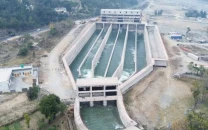Districts ranking: 48% schools in Pakistan without toilets, drinking water
New report puts Punjab, K-P ahead of Sindh, Balochistan on various educational parametres

New report puts Punjab, K-P ahead of Sindh, Balochistan on various educational parametres.
PHOTO: AFP
This has been revealed in the fourth edition of the annual Pakistan District Education Rankings 2016, which covered all 151 districts in the country to assess their education scores – based on levels of enrolment, retention, learning, gender parity and school facilities.
Pakistan has 24 million out of school children
According to the report issued on Tuesday, the top 22 districts are all from Punjab with the K-P’s District Mardan breaking in at the 23rd rank. FR Lakki Marwat stands on the bottom-most rung with 146th rank.
A new index for school completeness shows that only 52% of all government schools in the country have all four facilities – toilets, boundary walls, running electricity and drinking water. Only 24 of the 146 ranked districts scored more than 90 in school infrastructure score.
It also shows that a whopping 81% of all government schools are primary schools which imply that after the primary education, children in the country have limited opportunities to continue their education.
It said all provinces have generally declined in retention of students and gender parity except for Punjab, which has kept improving. However, district Lahore, regarded as the ruling party’s bastion, has gone down to 22nd rank as compared to its third position in 2015.
The district-wise ranking reflects that Islamabad and various districts of Punjab, Azad Jammu and Kashmir (AJK) and the K-P all have relatively improved on the education and infrastructure indices. However, the Federally Administered Tribal Areas (Fata), Balochistan and Sindh are performing consistently poorly.
Pakistan has world's weakest higher education system, say QS rankings
Individually, some districts have shown improvements; however, there is little to indicate any major nationwide improvement in either education quality or the quality of school infrastructure.

The federal capital is leading among all the provincial and regional rankings, as well as the district rankings for the first time with increased learning and enrolment scores.
Likewise, although Punjab’s education score decreased due to a decline in the retention score, it scored highest in gender parity. Last year the education score of the province suffered a drop in learning outcomes. However, three districts at the bottom half of the ranking are all from South Punjab – Dera Ghazi Khan, Muzaffargarh and Rajanpur.
While the K-P demonstrated improvements in both enrolment and gender parity scores, the retention rate of province has declined, consequently affecting the overall education score.
Recreation time: Play areas established in schools under new policy
On the other hand, the province is ranked higher at third in school infrastructure score, which indicates significant improvement. However 50% of its schools still lack the provision of all four basic facilities.
Balochistan and Sindh continue to manifest the lowest education and infrastructure scores. Balochistan’s education score has dropped. Except for Quetta (which is amongst the top 50), almost half of the districts of Balochistan rank outside the top 100.
Sindh has the lowest learning outcomes this year. Moreover, only six of its districts are on the top half of the rankings table. Once again, Karachi is the only district in the top 50. The state of school infrastructure also continues to suffer, where only 23% schools could be considered complete, having all four basic facilities.
The AJK has experienced the largest improvement amongst provinces/regions with a substantial increase in its education score. However the infrastructure score remains critical, with only 13% of the schools providing all basic facilities to children.
Although the Gilgit-Baltistan’s (G-B) progress has been stagnant over the past four years given the numerous challenges, the region still managed to show relative improvements with increased education score of 3%. Fata has demonstrated improvement in their education score by three per cent enabling it to outrank Balochistan.
Published in The Express Tribune, May 25th, 2016.



















COMMENTS
Comments are moderated and generally will be posted if they are on-topic and not abusive.
For more information, please see our Comments FAQ